
What does a successful nonprofit marketing strategy look like? Well, as a nonprofit marketer, you might have plenty of ideas for marketing. But still, with a busy schedule and limited budget, it can be hard to execute a cohesive strategy that truly drives results.
"92% of nonprofit professionals use content marketing to spread their organizations’ missions, but more than half don’t have a documented strategy for their content." – Content Marketing Institute
So what does a great strategy really look like? Sometimes, it's helpful to take a peek into what's working already. And today, we pull back the curtain on our successful nonprofit marketing strategy for Safe Horizon, the nation's largest domestic violence nonprofit.
Since our strategy for the site launched, Safe Horizon has increased the number of individual donations by 56% and yearly donations from $170,000 to over $230,000. And we fulfilled on three main organizational goals. Here's how.
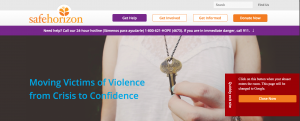
Sustainability is critical to all nonprofits. But when Safe Horizon approached Ironpaper, they needed to do more than invigorate donors and educate stakeholders. They also needed to create a safe, educational haven for their end users: victims of violence.
As our conversations began with Safe Horizon, several layers opened up. Safe Horizon represents people affected by domestic violence, child abuse, human trafficking, and other abuses.
So Rob Dickar, Director of Development and Systems Strategy, came to us needing a project that would embody the Safe Horizon mission, while keeping it sustainable and driving donor support.
For Safe Horizon, we decided on three major goals for the nonprofit's marketing strategy:
To solve these goals, we clearly needed to research and understand the unique needs of each audience.
While you could focus on things like new donor engagement, sustaining donor retention, community outreach, social media, content marketing... overall, all of your efforts should grow and sustain your organization. So wherever your greatest needs fall, that's where your marketing goals should be, too.
The first step for your nonprofit is to identify the primary 1-3 goals for your organization. Then, these goals should inform your marketing "next steps" — not the other way around.
This should be an organizational goal that informs your marketing. That's important! Because if you set goals backward, you may end up with a marketing plan that doesn't grow or sustain your organization.
For example, if you set a marketing goal first — "Let's increase Twitter shares by 250%" — this may not tie directly back to an operational goal, such as increasing donations. It's an indirect goal that spends resources. But it doesn't necessarily produce results.
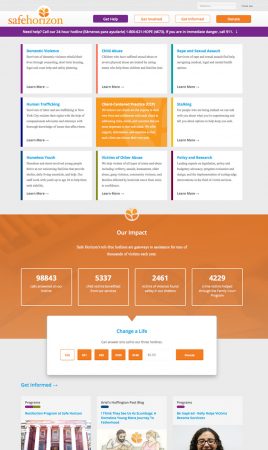 The new SafeHorizon website prioritized content organization so that we could reach each of the three major audiences clearly.
The new SafeHorizon website prioritized content organization so that we could reach each of the three major audiences clearly.
Safe Horizon was a massive educational site, but to fulfill on our three goals, the website needed to clearly cater to all groups: clients, professionals, as well as donors. And each segment is important in its own right, so we needed to speak simultaneously with all three personas… without creating three different websites.
How could we achieve this? With relevant, well-planned website content.
In a minute, we'll show you the exact exercises we used to plan website content and information architecture. But first, let's talk about the importance of strategic content planning.
While content is an incredibly important tool to fulfill on your goals, your nonprofit marketing strategy is of course limited by resources like time and budget.
So, you must determine: What are your content needs, and how can you simplify and prioritize the most important content to achieve your goals?
Of course, you could blog every single day, write a dozen case studies, and create a hundred new pages of content on your nonprofit website. But without research and planning first, you will get bogged down with so much content production. And it will not actually increase results.
Here are several exercises that we did for Safe Horizon, in order to develop content organization and prioritize the most important content projects.
First, we divvied up content into the buckets we would need — forming the basis for our information architecture. There was some overlap in content needs for different audiences, so that helped us prioritize the most important sections.
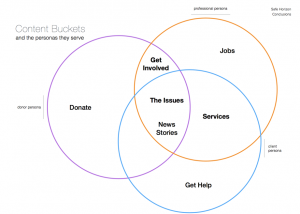
Overall, you must consider the user's needs for content. Our goals involved reaching three user groups — clients, professional groups, and donors — so it was important to analyze what would resonate with each group.
Your persona's needs are the most important thing. Why? Because content should never be created in a bubble of assumptions. Instead, you should always refer to your personas, conduct interviews, and refer to what's already performing well — as we did here.
This in-depth analysis, below, showed us what the personas were already searching for, reading, and converting on:
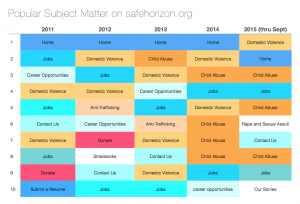
As you can see, we color-coded the top articles. This showed us visually which topics were most important to our audience.
But in addition to what's already working well, you need to find the gaps left by your existing content.
So, we spent time delving into each audience to further prioritize content needs:
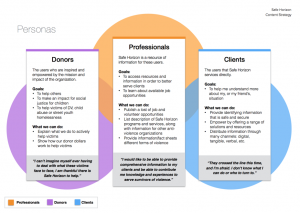
For example, Safe Horizon by name implies a place of safety that victims reach. So we learned that victims of assault often go through a learning process to discover they are actually being assaulted. But we felt the website lacked the right information to assist with this process — so that became a clear priority.
From this research, you'll start to see priorities emerge. For example, we learned that quick, clear information was necessary for end users. So we divided up our library into common user questions. Then, we responded to each question by highlighting a few sections of useful, relevant content based on the query.
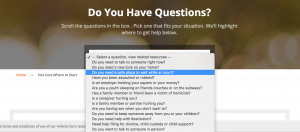
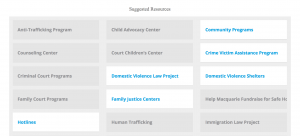 By organizing content by common questions, we met a main goal: Become more accessible to clients, AKA victims in need of help.
By organizing content by common questions, we met a main goal: Become more accessible to clients, AKA victims in need of help.
Content is a major piece of our Safe Horizon strategy. And for you, content can answer many of your digital challenges.
A solid content plan will attract, convert, and engage your audience. So no matter your specific goal, content can probably help drive your strategy.
Content, and the information architecture you use to organize it, will form the backbone of your website.
But content is a long game, and is often resource-intensive. So, in the meantime, there are quick wins that you can use in your nonprofit marketing strategy to improve your on-page performance. In marketing, we call this "conversion optimization."
For example, one of our Safe Horizon goals is to improve donations. But instead of launching a massive paid ad campaign, we improved the donation section we already had on our website. To do so, we "gamified" the donation amounts by adding specific impact statements for each dollar amount:
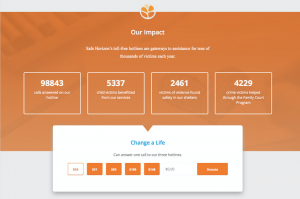
This simple change led to a large increase in donation conversions — and it was a much simpler and resource-light tactic than a huge campaign spend.
That is how you work "lean," which saves resources and minimizes failures. It's often based on analytics and analysis. That's how you identify quick wins that will actually make an impact.
For one example, we assessed the top-performing nonprofits in our space and studied other players in the industry:
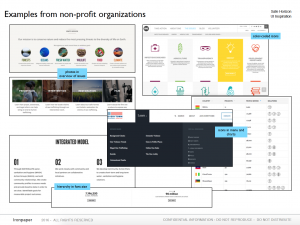
From this exercise and other research, we realized we needed an organization system to highlight Safe Horizon's range of causes. This system would also demonstrate impact more clearly. So, we developed this system to color-code our home page.
Each color represents a different "cause" and all the pages related to it:
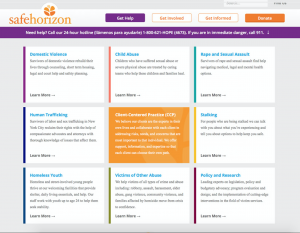
Notice how by reorganizing content, instead of rewriting a ton of content, we found a way to work lean while still improving the site experience.
Additionally, we surveyed site users to make sure the design and content was servicing them. To do this, we first focused on the website's navigation and the needs of users.
We mapped our user journeys — the steps our user groups take to become educated, then take action. This is an important step to determine how you should organize your website pages and determine which are actually important to improving your website conversions.
See below:
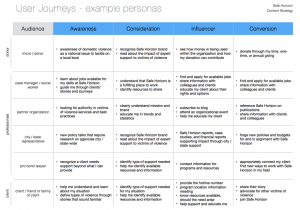
For example, if you research your page analytics and determine that your "About Us" page is getting no traffic and that it's not part of a vital user journey, you could avoid spending resources on redesigning and rewriting or promoting it for the near future.
By studying these user journeys and researching the nonprofit's audience, we identified several unique needs that were great lean first steps.
First, victims of violence are often in danger just for using a website. So, we needed to come up with some website design + navigation ideas to address this.
Our solution was Quick Escape: A bold, red button that opens a new browser tab to a fast-loading website.
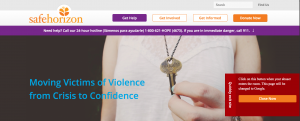 The "Quick Escape" red button at the right helped victims easily exit the website when they were in danger.
The "Quick Escape" red button at the right helped victims easily exit the website when they were in danger.
This technology lets us guide users out of the website when they are in danger — protecting their safety.
But what about their browsing history? We also created a way to “spoof” browsing history immediately. When a client clicks the Quick Escape, their browser history masks Safe Horizon. And if an abuser clicks the “back” button, they will see an inconspicuous Google search.
What can you take away from this example? Sometimes this biggest impact you can have on donors comes from a small optimization. And usually, this starts with researching and really digging into your audience persona.
An important part of any sustainable nonprofit marketing strategy is measuring analytics. Because without analytics, you can't see the return from each marketing action. But by continually analyzing, you can find content topics, strategies, and website pages that are generating the most return for your nonprofit. And then, you can continue investing there.
But which KPIs should you track? Read more in this article below:
Nonprofit Marketing KPIs — Metrics That Matter
So what have we learned about a successful nonprofit marketing strategy? You must:
Obviously, we've just scratched the surface here. But these steps will build a solid backbone for your nonprofit marketing strategy.
Want more help? Learn about partnering with a nonprofit marketing agency like Ironpaper to increase sustainability.
Sources
Content Marketing Institute. "2014 Nonprofit Content Marketing Benchmarks, Budgets and Trends – North America." https://contentmarketinginstitute.com/wp-content/uploads/2013/11/Nonprofit_Research_2014_CMI.pdf
by Jonathan Franchell, CEO of Ironpaper - For more tips and hacks: Need to remove a new line after h1 tags? Both web designers and SEO practitioners need to employ headline tags: H1, H2, H3 in several ways to improve web page structure and tag...

The Crowded Arena of the IT Marketplace Updated December 2024 The Information Technology (IT) landscape is experiencing rapid growth and intensifying competition. IT spending is projected to reach nearly 5.1 trillion U.S. dollars in 2024, a...

The marketing industry is transforming significantly due to generative AI and increasing market complexity. Gartner's prediction of a 25% decline in traditional search traffic suggests that the era of search engines is dying. AI tools, particularly...

Updated December, 2024 The field of digital marketing is evolving rapidly in response to new technology and changing buyer expectations. To help career-minded marketers, we’ve rounded up the top 10 skills needed to succeed in the field. These are...
